Walking with Sharks
|
Chris Scott |
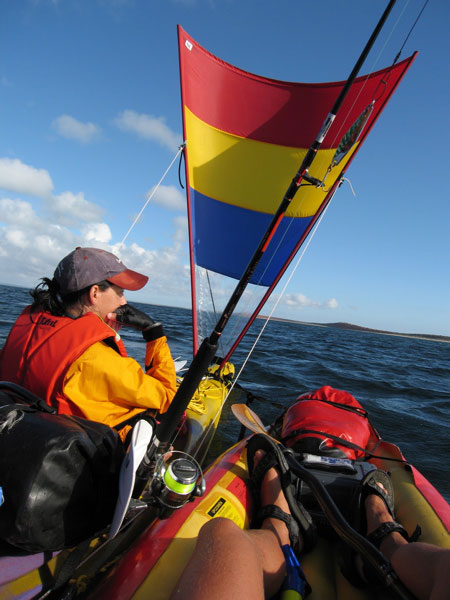
“Why doesn’t anyone paddle around Shark Bay, Jeff? It seems like a
great place. ”
“I think the name puts them off a bit” he replied. “It’s famous for
big tiger sharks; National Geographic made a documentary there once.”
“Oh” I said. “I thought it was just a name...”
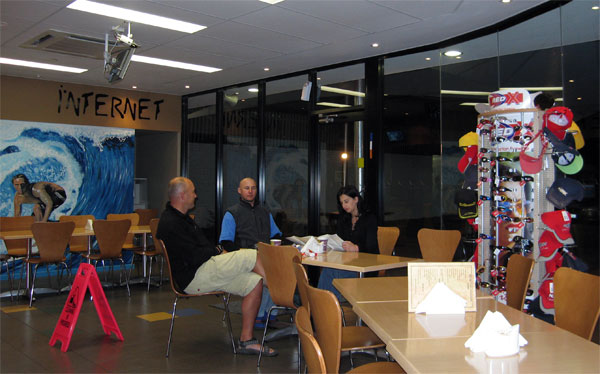
It was 2am in a roadhouse on the Coastal Highway north of Perth, Western
Australia (WA). I’d flown in from London that evening with my inflatable
kayak rolled up in a backpack and together with Jeff’s girlfriend Sharon
we hit the road for the 1000-kilometre drive to Shark Bay. The ‘bay’
actually comprises two thin peninsulas protruding north for 200 kilometres
and is best known for the daily dolphin visits on Monkey Mia beach.
A regular tide of tourists flows in and out of the resort there, but
I suspected there was more to see in the rest of the Shark Bay area
than Flipper and the family.
As dawn broke we crossed the 26th parallel with a sign welcoming us
to the fabled “Nor’ West”. Jetlag meant I’d been conveniently alert
for the overnight drive, but I still had a couple of frights, swerving
around kangaroos – an ever-present menace in outback Australia. The
sun rose as we rolled into Denham, Shark Bay’s only settlement, a mixture
of snowbirds jammed into the caravan park, pristine retirement bungalows
and some fishing and tourist operations.
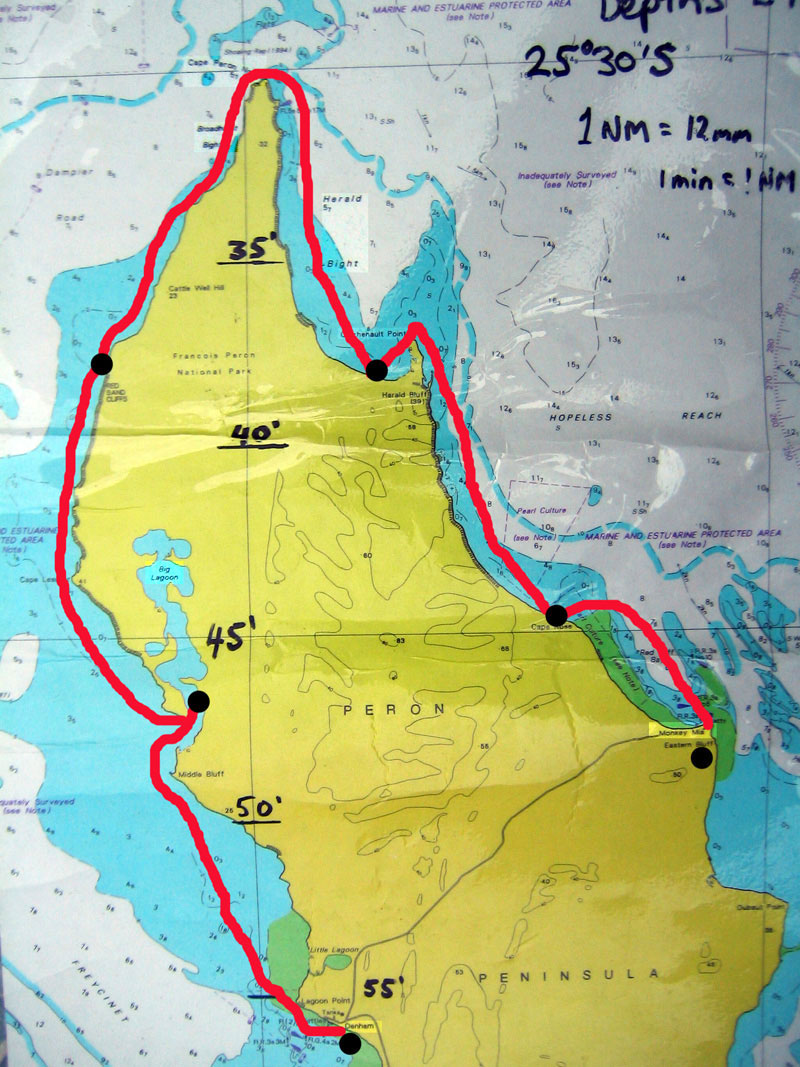
Our plan was not that ambitious. Paddle north from Denham about 60 kilometres
to the tip of the Peron Peninsula, round Cape Peron to the east, and
paddle the same distance back south to Monkey Mia Resort: about a one-week
trip. We aimed to take advantage of the prevailing southwesterlies on
the exposed northward stage and deal with the same as headwinds on the
more sheltered southbound leg. But first we followed a network of 4WD
tracks to the tip of Cape Peron and buried a cache of food and drinking
water at our halfway point. There was no water to be had on our route
and even the townsfolk of Denham have to pay a premium for desalinated
drinking water. Jeff and Sharon’s Perception Eco Niizh has the capacity
of a sea-going RV but my non-bailing Gumotex Sunny is less of a load-carrier
and I was keen not to reduce my freeboard too much.
To the Big Lagoon
With our cache stashed under the paprika-red cliffs of Cape Peron, at
dawn the following day we set out to sea: Jeff and Sharon in their tandem
hardshell sea kayak and me on my not so shark-proof ‘lilo’. The reliable
southwesterly pushed us steadily north, but within an hour wind turned
on us, obliging us to dig in for what ended up being two and a half
days.
We ploughed on, buoyed up by sightings of the extraordinarily rich
marine life that gives Shark Bay its World Heritage status. Sharon had
a checklist of must-sees: turtles, sharks, rays, dolphins and dugongs
(sea cows) – and by our first beach break a green turtle had already
passed beneath her bows. The pale green water was often only waist deep
up to a kilometre off shore and that afternoon, weary from paddling
against the wind, we took to towing our kayaks. As we waded through
the shallows, manta rays submerged on the sandy seabed took flight,
zooming off as if shot from a bow, their upturned wings surfacing momentarily
like twin fins. Strike two for Sharon.
Twenty kilometres out to sea Dirk Hartog Island broke the horizon;
the westernmost point of Australia. The eponymous Dutch seafarer recorded
the first European landing there in 1616, nailing an inscribed pewter
plate to a pole. What he saw of the newfound Terra Australis was uninspiring:
flat, arid and dense with scrub. It was another 150 years before Captain
Cook mapped Australia’s less harsh east coast and brought about British
colonization.
Another lone pole marks the mouth of Big Lagoon and as we rounded the
entrance a mass of cormorants took flight, the air filling with the
whiff of their oily wings. Though we’d snacked on some oysters during
our afternoon wade, the hard paddling has given us all an appetite and
we pulled in among some mangroves for an overdue feed and a reappraisal.
It was already 4 o’clock and with the tide and the wind against us we
decided to leave the exploration of Big Lagoon for another day and scooted
across the channel to the nearest sandy beach. We were beat but thrilled
by our first day’s efforts and an hour after sundown were zipped up
in our tents and fast asleep.
Walking with Sharks
The lagoon was glassy calm next morning and we set off to make the most
of it. Watching our boats glide over the seabed was to be a rare pleasure;
round the corner out in the open the northwesterly was waiting for us.
Heads down, we worked our way up the shoreline, occasionally man-hauling
the kayaks for a change of pace. As we did so tiny fish skimming over
the surface alerted us to the distinctive tail and dorsal fins chasing
them and soon metre-long sharks began darting between our boats, racing
at us then veering off at the last minute in a flurry of spray. We presumed
our bulky kayak silhouettes kept them from actually going for us, something
which Sharon confirmed as she walked away from the boat - and then ran
screaming - for the beach with sharklets homing in for a nip!
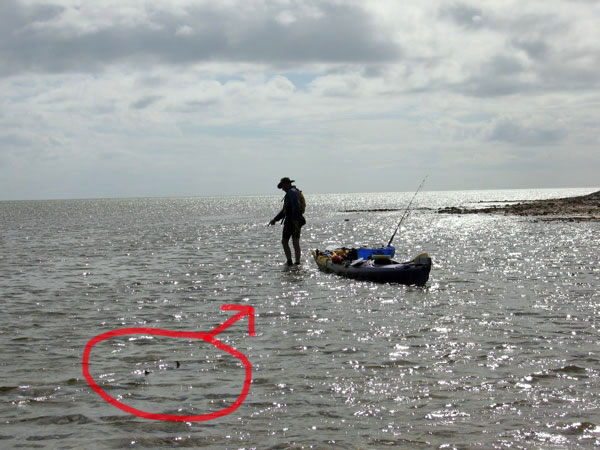
Presently the waters cleared and we hopped back in for a paddle, steering
out into the wind around sand banks below a line of ochre-red cliffs
several kilometres long. It looked like a great place to camp so we
hauled the boats in over the sand flats and with daylight to spare,
wandered off up and down the deserted beach in search of firewood. I
found a washed-up conch the size of a watermelon while Sharon and Jeff
came across a midden of oyster shells left either by 19th-century pearlers
or by the Yamatji Aboriginal people who’d occupied the Bay prior to
colonization.
Cape Peron
Up with the sun again, but there was no calm put-in this morning. It
would be another tough struggle to reach Cape Peron and our cache. By
9am Jeff estimated it was blowing at 20 knots.
“What’s that in English!?” I yelled through the spray.
“About 30 clicks!”
Was it possible to paddle against 30kph? My blow-up boat flexed over
the swell as the Indian Ocean crashed against the shore. Still, every
vicious headwind had a silver lining and as we dug away a pair of dolphins
popped up to say G’day. Less than 48 hours into our sea safari and we
now had only the elusive dugongs to tick off.
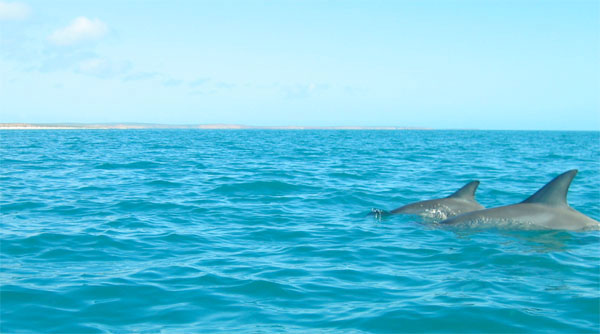
By noon the seas were getting as big as I’d ever experienced but I
figured as long as Jeff and Sharon didn’t disappear behind the swell
it couldn’t be that bad. After a quick shore snack we set off across
Broadhurst Bight, a punishing slog with confused seas barging into our
boats from all sides. Occasionally I had to clip onto Jeff’s stern to
bail my boat out as the distant shore inched by. Eventually we staggered
onto a sandy headland, having covered just five kilometres across the
Bight in two hours. The good news was that our morning’s efforts had
put us just a couple of clicks from our cache at Cape Peron and sure
enough, just forty minutes later, with my boat swilling with seawater,
we managed to land.
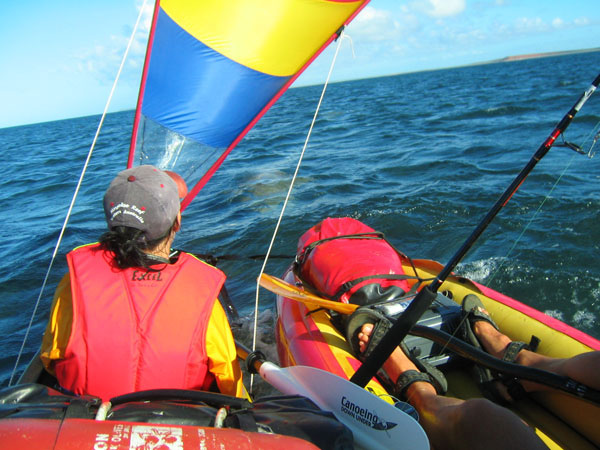
The Cape is one of the few places in WA where you can see the sun set
and rise over the sea, but that day it was just too exposed for a camp.
Anyway, there was another reason we were keen to keep going: we were
turning south and the wind would at last be out of our face! We loaded
up the stash, launched back off the beach and, once the two boats were
lashed together for stability, Jeff hoisted his secret weapon: a Pacific
Action sail which filled instantly with a satisfying slap. Soon we were
skimming along at two or three times our paddling speeds, water lapping
over our bows, past the lighthouse at Skip Jack Point and southeast
into Herauld Bight.
Sailing with Dugongs
We were sitting back, dangling our arms in the water, enjoying chatting
without yelling and generally feeling rather pleased with ourselves
when the ever-observant Sharon exclaimed “Dugongs!!” Below us three-metre
long mud-coloured profiles emerged against the dark seagrass bank on
which they were feeding. Before long we were right among a herd of twenty
or more sea cows, which had been caught unawares by our stealthy windborne
raft. At times our bows nearly ran over them, the water ahead of us
exploding as their powerful tail flukes blasted them out of range. Once
clear, they’d pop up to catch their breath and take a curious look back
at our asymmetric contraption.
The encounter with the strange dugongs was a highlight but after nearly
three days with our heads down, sailing was up there too and we wanted
all we could get. We pushed on from one cape to the next until we eventually
ran into the shallows of Herault Bight. Our unexpected run downwind
had doubled our day’s mileage but it was already getting dark. I went
foraging for firewood while Sharon and Jeff got cooking. Although Jeff
had been fishing out of the boat for days, short of the Big Five, we’d
not spotted a single mealworthy fish.
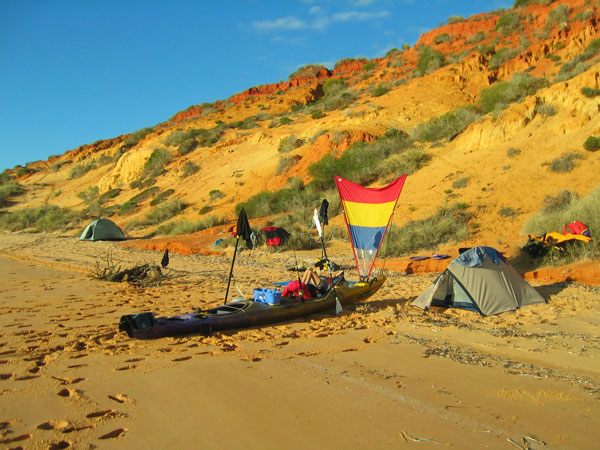
My boat sat on its edge between two paddle shafts, sheltering the camp
while the wind fanned the nearby fire. Soon wafts of a gorgeous and
faintly familiar aroma began to drift across to us. Intrigued, I walked
back to the fire and realised one especially large chunk was sandalwood.
A century ago Western Australia had got rich supplying sandalwood incense
to Asian temples and the very last reserves were said to be in Shark
Bay area. And I’d inadvertently chucked some of it on the fire! We pulled
the log off, wolfed down another meal and, with the wind still blasting
down the bight, retreated to our tents.
Across Hopeless Reach
That night a storm blew through, filling my fly-less tent with water
and turning Jeff and Sharon’s inside out. By the time all was dry and
packed next morning the tide had come in to meet us and we headed off
towards the curious Guichenault Point, a pencil-thin spit that protrudes
a kilometre from the shoulder of Herault Bight like a jetty. The west
wind was so strong we had to clamp the rafted kayaks close together
as we windsurfed the five kilometres to the Point in just half an hour.
As we turned the tip of the spit half an hour later, the usual array
of cormorants took to the air, joined by portly pelicans rising effortlessly
onto the wind.
We were now entering Hopeless Reach, one of many gloomily named bodies
of water christened by early visitors to Shark Bay. Fittingly, our downwind
cruise came to an end. Though for the rest of the day promising tailwinds
occasionally spiralled down from the cliffs, it was back to good old-fashioned
paddling, albeit on much smoother water.
We were already nearing Monkey Mia Resort and so decided to string
out our time with shoreside excursions up the cliffs, sailing at 1mph
for the hell of it and more fruitless fishing. By mid-afternoon we could
see Cape Rose a few kilometres from the resort. A pearl farm pontoon
was moored up ahead and Jeff was keen not to get too close. He’d once
worked on such a platform and knew how edgy the crew could get when
strangers approached; guns were often pulled. We paddled slowly by but
as we got nearer it was clear it was unoccupied and so we headed ashore
to make the most of our last wild camp.
Back on the water next morning and suddenly it was nearly all over.
A lone bottlenose dolphin cruised past me and a pod cavorted around
Jeff and Sharon as I tried to grab a shot. But soon buzzing outboards
and a tourist catamaran took their place as we neared the resort. By
the size of the crowd strung out along the palm-lined beach, a ranger-led
dolphin encounter was in progress.
We beached the boats one last time and headed to the café for
a king-size fry-up before Jeff hitched back to Denham to collect the
van. As I washed down my kayak with our excess fresh water another visitation
ensued. Sure it’s fun seeing a dolphin close up, but the three of us
could not help feeling rather smug about our discoveries out in the
Bay. They were standing ankle deep with half-tame dolphins but we’d
worn the paint off our paddle shafts, sailed with dugongs and walked
with sharks!
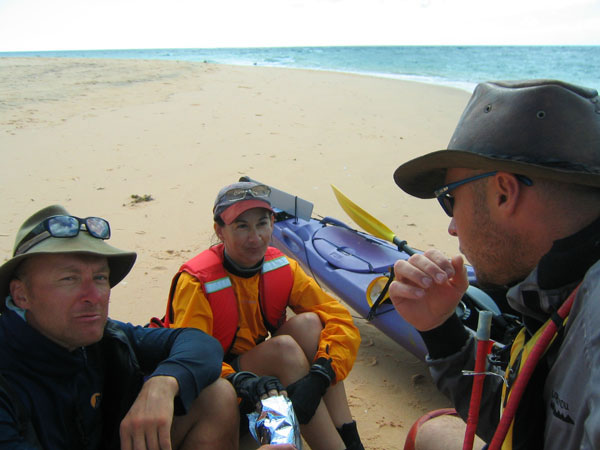
There are more pictures - click
here
When
WA’s west coast is better known for wind surfing and of course scorching
summers so the best time to paddle around Shark Bay is the middle the
southern winter (our summer) so your water consumption will be much
reduced. Winds at this time usually come from the southwest and are
managable, as are temperatures at around 25°C in the day and 10°C
at night. Cyclones affect the northern coast, especially at the start
and end of summer, with the exposed North West Cape especially prone
to storms.
Getting there
Shark Bay is 1000km north of Perth along the North West Coastal Highway.
Roadhouses are up to 200kms apart and not open round the clock. Besides
the already mentioned hazard of night-time kangaroos, triple-trailer
road trains should also be treated with caution. Car rental in Perth
is among the cheapest in Australia.
Planning
For sea kayak touring you’re on your own in Shark Bay; we’d only ever
heard of one other person doing it although it’s clearly a great location
and straightforward to organise. You’ll need to bring or rent your own
boats and gear although the supermarkets in Denham will have all the
provisions you need.
Access
Despite being a UNESCO World Heritage listed site and part of the Shark
Bay Marine Park, no special permits are required to paddle Shark Bay.
In one or two places there are basic 4WD-access only camp sites which
lead back to Denham but all you’ll find in these places is a toilet
and the odd recreational fisherman.
While in the Shark Bay area don’t miss out on a visit to Eagle Bluff
Lookout, Shell Beach (made up of millions of tiny shells) and the strange
stromatolites. Rock-like lumps of algae, Earth’s earliest known life
form evolved 3.5 billion years ago and today survive in the hyper-saline
lower reaches of the Bay too salty for predators.
Alternatives
Shark Bay’s sheltered lagoons make it an ideal introduction to sea kayak
touring in WA. Elsewhere the coast is more exposed. You can rent hardshell
sea kayak out of Freemantle or Rottnest Island near Perth, as well as
on the North West Cape alongside the fabulous Ningaloo Reef, another
500km north of Shark Bay. That’s where we’re heading for next year.
Health hazards
We stumbled across a relatively harmless shark nursery; bigger tiger
sharks tend to stay out in the deeper water where there is more to eat.
A much more likely hazard is exposure from the sun, reflected glare
and wind. Wear a wide-brimmed hat, long sleeved shirt and sun glasses
and use sun block.
Maps
A good marine chart of the Peron Peninsula can be obtained from the
Perth Map Centre. 900 Hay Street Perth. Tel +618 9322 5733, sales@perthmaps.com
Websites
http://www.sharkbay.org
gives a full picture of the area’s many interesting features.
http://www.topkayaker.net
focuses on sit-on-top and inflatable kayak touring.
http://www.canoeingdownunder.com.au/trips.php
includes WA kayaking legend Terry Bolland’s hair-raising trips along
the WA coast.
Equipment
Hardshell sea kayaks are more conventional and can carry a huge load
but are very heavy and of course awkward to transport by air. My Gumotex
inflatable and associated gear came in under an intercontinental flight’s
baggage allowance and the very stable boat (made of tough raft vinyl)
pumps up in ten minutes.
Gear is best carried in sealed kayaking bags lashed to the boat. Self-bailing
inflatables are probably better for rough conditions but IKs can’t sink.
Any sea kayak with a rudder helps you maintain a course across side
winds without overworking one arm to compensate. Once off the water
all gear needs to be rinsed in fresh water and properly dried.
Author profile
Chris Scott writes the WA and Northern Territory chapters for the Rough
Guide to Australia although he spends most of his time in the Sahara
writing Sahara Overland and the Adventure Motorcycling Handbook for
Trailblazer Guides. He’s just updated Trailblazer’s Pennine Way guide
due in 2007.
Spending too much time with machines, a day trip on Idaho’s Salmon River
turned him onto inflatable kayaks. Since then he’s paddled among the
Scottish Summer Isles and Eurostar-ed down to the Dordogne and Haute
Allier rivers in France. In 2008 he plans to return to WA to paddle
the North West Cape. His main website is sahara-overland.com
|







